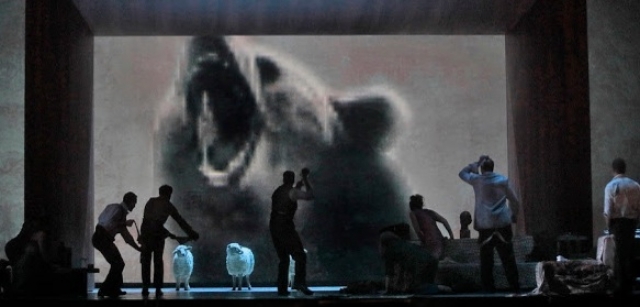The Exterminating Angel by Thomas Ades
American Premier Has Gleaming Cast
By: Paul J. Pelkonen - Nov 01, 2017
That which is new and innovative in the world of opera is often distinctly unwelcome. Harried critics usually get one hearing before having to hold forth as to the quality of a new piece. Subscribers from suburbia, eager to experience culture, often trade in their tickets to avoid anything written in the past hundred years that isn't Turandot. However, the creation of new works remains how the art of opera continues, against steep odds and media indifference, to grow and survive. This week, the Metropolitan Opera did their bit by opening Thomas Adès' latest opus: The Exterminating Angel.
Adés and librettist Tom Cairns adapted El Angel Exterminador, the surreal 1963 film by Luis Buñuel. The opera (the production is by Cairns) starts imperceptibly. Before the house lights go down, bells chime from the orchestra pit. A projection of palm trees, headlights and city streets appears on the black scrim curtain. And then suddenly, one is immersed in the sound-world of this opera, an endless and inventive score under the baton of Adés himself.
This is the story of a high society dinner party that goes horribly awry. Elites rubbed elbows with an opera singer, a pianist and a venerable doctor. Somebody brought a circus bear on a leash (shades of Siegfried!) and there were sheep (played by actual sheep!) loose in the house. The human guests snipe at each other, and then they discover that none of them can leave the drawing-room. The food quickly ran out. Starving, scared and exhausted, these folks must endure each others' company for far longer than they would like. (In other words, this is every New Yorker's nightmare, writ large.)
Clad in evening gowns and formal wear, the cast spent most of this show underneath an enormous square arch that moved slowly and majestically on the Met's 50-year-old turntable. The arch is a symbol of their confinement, an oppressive structure that looms overhead, dwarfing the singers. For three acts, the singers also have to battle Adés' two-fisted orchestration, which includes heavy brass and percussion, complicated writing for winds and the ondes Martenot. Adés' writing is claustrophobic, using his signature technique of slab-like chords and heavy orchestration to enhance the feeling of confinement and gloom. However, there are rays of sunshine in the thick web of sound and witty references including two to the composer himself.
The first act was mostly setup. A cast of servants appeared, chattered and (as in Strauss' Elektra) became quickly irrelevant. Adés and Cairns gave the ear and imagination a lot to process in the first hour and a half. A sense of growing dread permeated every bar. As their situation becomes clear, these glittering characters slowly lost their sanity and humanity. They became debased, depressed, suicidal, and ultimately violent. With three exceptions, most of them survived, but the experience of their confinement was unsettling, and finally shattering to witness.
The third act was hard to watch too, but easier to process. As the surviving characters woke up, things went downhill fast. The partygoers punched a hole in the floor to get water. One of the sheep was killed in the opera's most effective moment. This grisly Straussian murder (again, shades of Elektra) was pounded out by the orchestra, which then dwindled into sickening silence. The survivors fed themselves by roasting said sheep over a primitive fire, fueled by burnt and broken musical instruments. However, their paranoia and tension remained at a peak. The doctor struggled to maintain order, but the more spiritually crazed guests start planning some kind of weird religious sacrifice. This is thankfully stopped in its tracks.
The Met spared no expense on a lavish cast. The parade of names was led by Alice Coote, a veteran of this kind of modern opera. Other notable voices included baritone Rod Gilfry, soprano Amanda Eschalez (as Leonora, the evening's hostess) and the veteran British bass Sir John Tomlinson (in very raw voice) as her doctor. Soprano Sally Matthews and countertenor Iestyn Davies play a pair of incestuous siblings, another Wagnerian trope. Another pair of lovers: Beatriz (Sophia Bevan) and Eduardo (David Portillo) had an amazing scene together: a compression of Tristan und Isolde staged in a coat closet, with similar, tragic results.
Adés saved his final peroration for Leticia, played by super-soprano Audrey Luna. Her small, stratospheric voice kept going up and up in the work's climax: to the point where one wondered if the composer is writing for a canine audience. The altissimo register made the text sound garbled when clarity is essential, and the piping sound quickly wore out its welcome. This exuberant moment was followed by a downer of a final chorus. The entire cast and chorus found themselves trapped in by the oppressive archway. The remaining sheep were nowhere to be found. (Reprinted with permission of Superconductor.)

